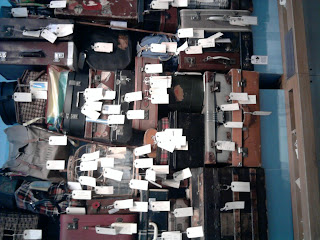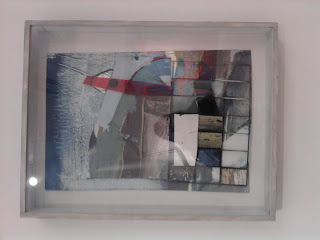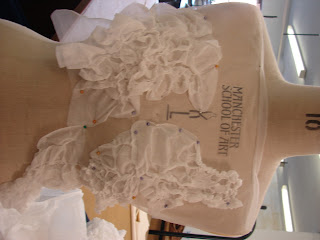Similarly to the Dark matters exhibition, the interactive section on the 1st floor always attracts me. Reading the small tags left on the suitcases cn be really touching, but also is a shcking reminder for me of just how many children were evacuated.
Also on the 1st floor, the work of Adolphe Valette, especially Hanson Cab at All Saints 1910. I feel a strong connection to this image as I see this view over the park every day. It is an interesting idea to mirror the two different times and relate similiarties and differences and maybe merge them together.
The mixed media used in Built up Coast 1960, Peter Lanyon is inspirational to me beceause it was a way I always used to work, but haven't done since starting my degree. The layering of different materials to build up a beautiful surface is something I want to bring back into future work.
Sunday, 4 December 2011
Manchester Craft Centre
I am attracted to the idea of a community of artists with small shops and workshops all crammed together into a warehouse. Each shop seems to look after others whilst they are busy, and all the artists are eager to talk.
Lilly Greenwood
The vibracny of this work really excites me, and the way inwhich she the work is able to transcend into different outcomes such as cards and keyrings.
Lilly Greenwood
The vibracny of this work really excites me, and the way inwhich she the work is able to transcend into different outcomes such as cards and keyrings.
Cornerhouse
Rashid Rana
The idea of internal conflict which is translated through mirror images and symmetrical grids. It isn't a type of art I would ever consider, but I like how some pieces are pixilated and others seem pixilated but when lookd at closely are made up from other images.
These include Winter Fuel - John Everette Millais 1873, a picture created with the same photo tessalated in different brightnesses to create a larger picture of the same place.
The idea of internal conflict which is translated through mirror images and symmetrical grids. It isn't a type of art I would ever consider, but I like how some pieces are pixilated and others seem pixilated but when lookd at closely are made up from other images.
These include Winter Fuel - John Everette Millais 1873, a picture created with the same photo tessalated in different brightnesses to create a larger picture of the same place.
Whitworth Art Gallery
Dark Matters
I like how interative a lot of the pieces are such as Daniel Rozin 2006, Snow Mirror which allows the audience to become a part of the work by standing infront a screen and having the snow shapes create your outline.
Also the work of Elin O'Hara Slavick. This takes the audience by surprise after a such fun and interactive, with images of items such as flowers after the atomic bomb. The ghostly white imprint left on a blue background reminds us of things missing, and the idea of something being obliterated without any choice.
I like how interative a lot of the pieces are such as Daniel Rozin 2006, Snow Mirror which allows the audience to become a part of the work by standing infront a screen and having the snow shapes create your outline.
Also the work of Elin O'Hara Slavick. This takes the audience by surprise after a such fun and interactive, with images of items such as flowers after the atomic bomb. The ghostly white imprint left on a blue background reminds us of things missing, and the idea of something being obliterated without any choice.
Costume Gallery
It is set out in the easiest way to find the era most interested in and there is an interesting mix of modern installation work and ancient wearables. It is also a great source for Victorian lace.
Thursday, 17 November 2011
Latex Rock Samples
I started experimenting with creating a mould out of paper then painting with the latex. This worked really well, and it was fun so see the changes in colour and texture as the latex dried.
It is a quick technique once it is started, but it does take a while to create the mould to cast the latex onto.
It's hard to keep this technique tidy, but is a lot of fun peeling the latex from the mould. The paper did stick in some places so it wasn't just latex by the end. You also need a lot of layers to make the latex thick enough to have enough strength. The layers do dry quickly though.
1st attempt of putting the latex onto the body. I thought mixing latex and the tyvek together would work, but I don't like the different colours together. The gament also has too much structure, I think there needs to be some loosness and connetion to fabric. Done some research into melted rock and lava, which relates well to the latex samples: creating a solid from a liquid.
I like the idea of the garment flowing, there's movement. The connection between fabric and plastic works well and reminds me of maybe different rock plates meeting, a joining of two very different materials.
Connecting the fabric with latex again. I created rips and scores in the fabric and pleated where it joined to the latex which manage to mirror eachother more. I also managed to relate the hand processes to this project finally because all the sewing is hand done and I have incorporated drawn threadwork to add texture.
Where the latex and fabric meet. I liked hand sewing this seam because it was quick and created moore interest by being messy. I also like the relationship of colours, they blend well together and bring two very different materials.
Instant Filler Rock Samples
None of the samples I had experimented with had actually had the coled, hard rock surfaces which related so well to rocks. So I started using instant filler which was easy to mould and had a really beautiful surface once dried.
I found it really hard to find a way of connecting all the pieces together without cracking the surface, so I don't think this would be an appropriate material to use to make a wearable object. It's a shame because had the most realistic appearance, but the tyvek and latex samples definately rereate the shape and idea of what I wanted to produce in this project. Plus these samples were really useful as moulds for the atex!
Tyvek Rock Samples
Sample of tyvek which has been heated under the grill. The glue melts and causes the fabric to shrink and bubble up. Once cooled, the glue sets and the fabric becomes hard. This links well to the thes in my project ad enables me to link ideas of shapes I have already come with to fabric and a slightly more conventional material.
Experimenting with a lot of samples on the bdy at once. This is using the tyvek to form a fabric. I like how it is following the shape of the body and is restricted to this, but I think it would be more appropriate to the rock theme if the garment was somehow disrupting or blocking off the shape of a body and forcing the shape of rocks on a person.
Like the idea of small sections of tyvek linked together with a sheer fabric so it is a complete fabric, but at the same time has an edge. I tried this with dissolvable fabric, chiffon and white plastic bags. I think the most successful was the chiffon becasue it want completely see through.
Most recent idea for tyvek. I love the way it resembles a costume, witht the embellishment ontop of a sheer fabric. It seems theatrical but at the same time the chiffon is hard to work with because it frays so easily.
Attempts of adding colour. This is acrylic paint. I think the colour is too strong, and whereas when just left white the small dots of glue add texture; when colour is added, the white dots stay white and make the fabric look less natural. This material is definatley better with no colour added to it.
Photocopying the tyvek samples is really fun. When the light is moving across the fabric, sliding the sample out causes therock to look sticky and molten and viscous. This has moved my project into looking at lava and the other side of rocks deep under the earth. Rocks which move and are almost alive with currents. Moving planes meeting moving planes with violent consequences. It's really exciting.
Tin Foil Rock Samples
This was a spur of the moment idea to use tin foil, and the overall aesthetic appearance of the samples. They have a lot of depth, and are so easy to mould to the exact shape. A lot of difference in scale can be created too with large planes of reflective faces mixed with scrunched up tightly packed facets.
The appearance is very elaborate and beautiful but the problem is the materil is so temporary. You can't transport any section because the flat parts with become scrunched up and its not easy to join together because the foil is delicate. Using foil has been really useful to think abou shapes I want to create. But turning into fabric will be the best idea because it will be the most wearable and the easiest to create into an actual garment.
Attempting to add colour to the foil. I was disappointed to begin with about thelack of colour the foil took, but once it dried I really like the faint hint of colour. The colours are a lot more delicate and pretty rather than brash.
Page from sketchbook. I like how easy the material is ti maipulate onto both the actual body and drawn figures of the body. It is a good tool so start thinking about shape.
1st drawing workshop. 15 drawings in 2 hours, sounds easy but you lose track of time very quickly and the last few end up rushed. The 1st two drawings were of architecture, and the 2nd two hours were drawing from abstract words and sentences. I found the 2nd set of drawings very releasing because I had never heard of drawing from words as being a valid technique and has been a useful technique in this project.
The dog drawing project was ploughing through a number of techniques very quickly. These included negative space drawing, blind drawing, drawing at different speeds and different pressures. This was releasing to do so many drawings so quickly but it would've been nice to have been able to focus and get to grips with a couple of techniques rather than going through so many.
Thursday, 10 November 2011
Front Cover of A10 Magazine
Taking the same idea I have, but pushing it to the extreme with scale. I love this piece on the wall, it has become part of the wall and seems to grow out of it.


Lucie Hallenstein
This again relates to my folded paper piece and is inspiring me to work bigger. i love how it drapes so that the top looks hard and sculptural and the bottom sways and looks more like fabric.




Matt Shlian
This relates to my 1 metre by 1 metre drawing because of the use of white paper onto a white surface. But these are perfect geometric patterns . I like the use of paper 'reverse appliqué' so is being sculpted into the paper rather than out of it.






Delfina Delettrez
This idea follows the same pattern as my first idea in 3D construct of depicting tendons, and creating a wearable completely relating to the body.
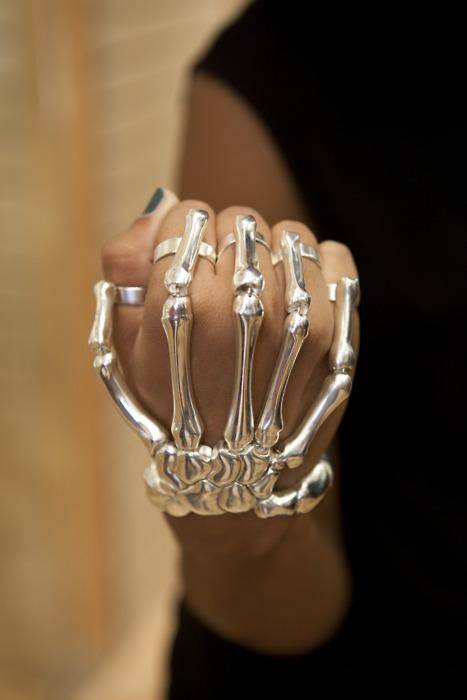

Iris Van Herpen
Escapism
I love how far the sculptural and intricate elements of Van Herpen's work has been stretched. Her work is inspirational to my project because it uses the idea of covering up the shape of some parts of the body and leaves other parts visible or at least highlighted. they also seem stiff, like they are only there to describe the form and to suggest shapes on the body without thinking how these would become practical garments.



I love how far the sculptural and intricate elements of Van Herpen's work has been stretched. Her work is inspirational to my project because it uses the idea of covering up the shape of some parts of the body and leaves other parts visible or at least highlighted. they also seem stiff, like they are only there to describe the form and to suggest shapes on the body without thinking how these would become practical garments.



Lucas Simoes
Cut-out portraits.
This artist manages to relate my first two workshops together with the use of sharp edges and boxy shapes, and the hand processes technique, reverse appliqué. i love the idea of cutting away and working down to create 3D shapes rather than working up. This could be used well as a drawing technique because it is a bit flatter than the metre by metre drawing I have done yet still has a tactile element and hint of 3D which relates well to my project.
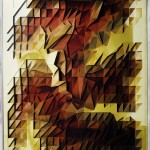
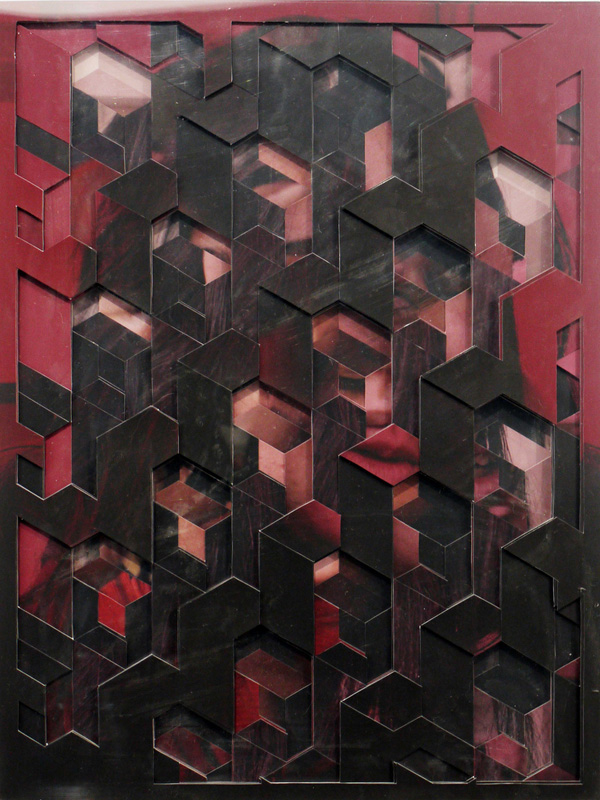
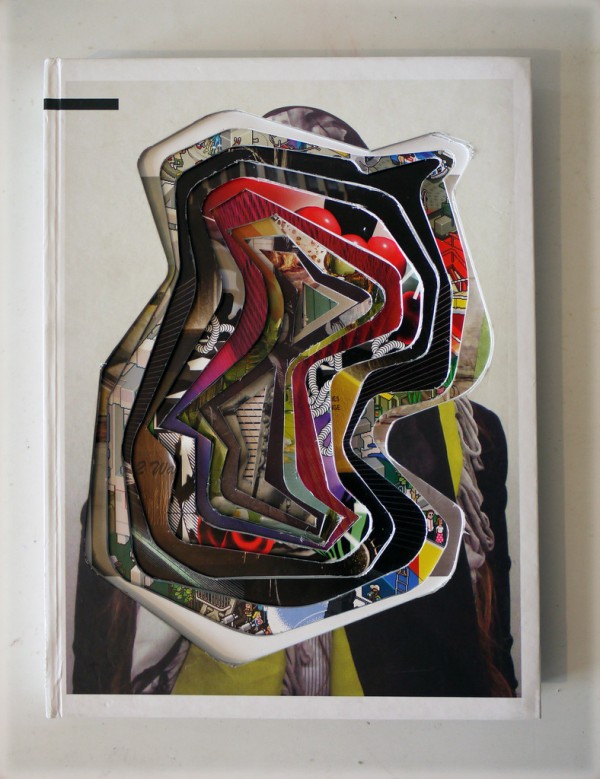
This artist manages to relate my first two workshops together with the use of sharp edges and boxy shapes, and the hand processes technique, reverse appliqué. i love the idea of cutting away and working down to create 3D shapes rather than working up. This could be used well as a drawing technique because it is a bit flatter than the metre by metre drawing I have done yet still has a tactile element and hint of 3D which relates well to my project.



Andreia Chaves
Andreia Chaves
This work has the same ethos as my own project of finding beauty in chaos. I love the intricate design and the natural, organic shape which is created from something to unnatural as a perfect cube.
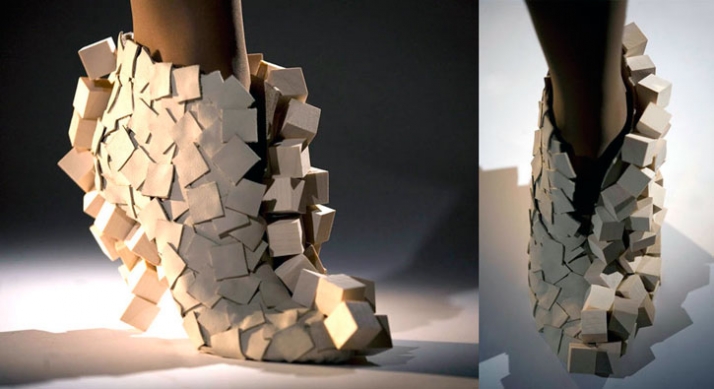
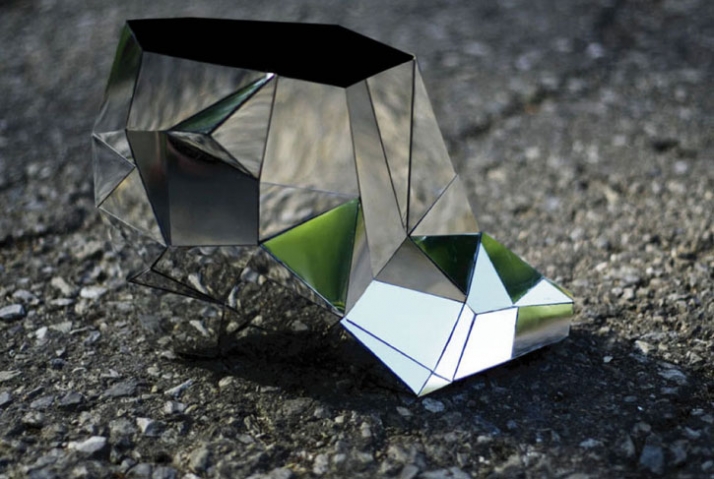
This work has the same ethos as my own project of finding beauty in chaos. I love the intricate design and the natural, organic shape which is created from something to unnatural as a perfect cube.


Alba Prat
I find this work inspirational for this project because Prat is not ashamed to go completely sculptural. It's so different from a body form, yet is completely complementary of it. I am also inspired by the use of such a synthetic material because is is so necessary for the work she is creating and because I am nervous of using it is my own work.

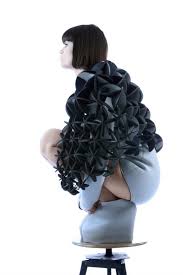



Subscribe to:
Posts (Atom)
